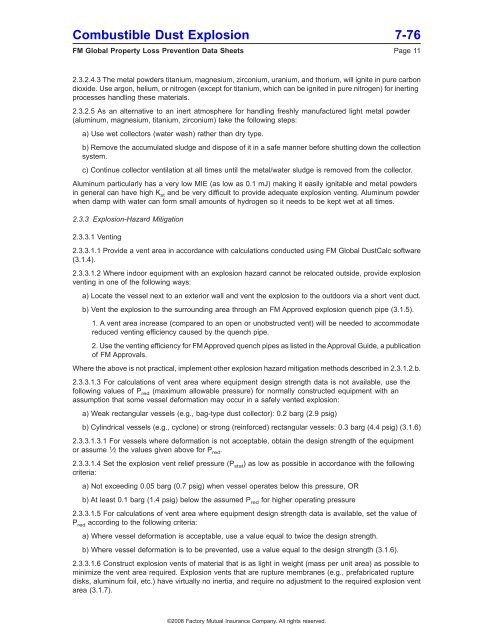DS 7-76 Prevention and Mitigation of Combustible Dust ... - FM Global
DS 7-76 Prevention and Mitigation of Combustible Dust ... - FM Global
DS 7-76 Prevention and Mitigation of Combustible Dust ... - FM Global
You also want an ePaper? Increase the reach of your titles
YUMPU automatically turns print PDFs into web optimized ePapers that Google loves.
<strong>Combustible</strong> <strong>Dust</strong> Explosion 7-<strong>76</strong><br />
<strong>FM</strong> <strong>Global</strong> Property Loss <strong>Prevention</strong> Data Sheets Page 11<br />
2.3.2.4.3 The metal powders titanium, magnesium, zirconium, uranium, <strong>and</strong> thorium, will ignite in pure carbon<br />
dioxide. Use argon, helium, or nitrogen (except for titanium, which can be ignited in pure nitrogen) for inerting<br />
processes h<strong>and</strong>ling these materials.<br />
2.3.2.5 As an alternative to an inert atmosphere for h<strong>and</strong>ling freshly manufactured light metal powder<br />
(aluminum, magnesium, titanium, zirconium) take the following steps:<br />
a) Use wet collectors (water wash) rather than dry type.<br />
b) Remove the accumulated sludge <strong>and</strong> dispose <strong>of</strong> it in a safe manner before shutting down the collection<br />
system.<br />
c) Continue collector ventilation at all times until the metal/water sludge is removed from the collector.<br />
Aluminum particularly has a very low MIE (as low as 0.1 mJ) making it easily ignitable <strong>and</strong> metal powders<br />
in general can have high K st <strong>and</strong> be very difficult to provide adequate explosion venting. Aluminum powder<br />
when damp with water can form small amounts <strong>of</strong> hydrogen so it needs to be kept wet at all times.<br />
2.3.3 Explosion-Hazard <strong>Mitigation</strong><br />
2.3.3.1 Venting<br />
2.3.3.1.1 Provide a vent area in accordance with calculations conducted using <strong>FM</strong> <strong>Global</strong> <strong>Dust</strong>Calc s<strong>of</strong>tware<br />
(3.1.4).<br />
2.3.3.1.2 Where indoor equipment with an explosion hazard cannot be relocated outside, provide explosion<br />
venting in one <strong>of</strong> the following ways:<br />
a) Locate the vessel next to an exterior wall <strong>and</strong> vent the explosion to the outdoors via a short vent duct.<br />
b) Vent the explosion to the surrounding area through an <strong>FM</strong> Approved explosion quench pipe (3.1.5).<br />
1. A vent area increase (compared to an open or unobstructed vent) will be needed to accommodate<br />
reduced venting efficiency caused by the quench pipe.<br />
2. Use the venting efficiency for <strong>FM</strong> Approved quench pipes as listed in the Approval Guide, a publication<br />
<strong>of</strong> <strong>FM</strong> Approvals.<br />
Where the above is not practical, implement other explosion hazard mitigation methods described in 2.3.1.2.b.<br />
2.3.3.1.3 For calculations <strong>of</strong> vent area where equipment design strength data is not available, use the<br />
following values <strong>of</strong> P red (maximum allowable pressure) for normally constructed equipment with an<br />
assumption that some vessel deformation may occur in a safely vented explosion:<br />
a) Weak rectangular vessels (e.g., bag-type dust collector): 0.2 barg (2.9 psig)<br />
b) Cylindrical vessels (e.g., cyclone) or strong (reinforced) rectangular vessels: 0.3 barg (4.4 psig) (3.1.6)<br />
2.3.3.1.3.1 For vessels where deformation is not acceptable, obtain the design strength <strong>of</strong> the equipment<br />
or assume 1 ⁄2 the values given above for P red.<br />
2.3.3.1.4 Set the explosion vent relief pressure (P stat) as low as possible in accordance with the following<br />
criteria:<br />
a) Not exceeding 0.05 barg (0.7 psig) when vessel operates below this pressure, OR<br />
b) At least 0.1 barg (1.4 psig) below the assumed P red for higher operating pressure<br />
2.3.3.1.5 For calculations <strong>of</strong> vent area where equipment design strength data is available, set the value <strong>of</strong><br />
P red according to the following criteria:<br />
a) Where vessel deformation is acceptable, use a value equal to twice the design strength.<br />
b) Where vessel deformation is to be prevented, use a value equal to the design strength (3.1.6).<br />
2.3.3.1.6 Construct explosion vents <strong>of</strong> material that is as light in weight (mass per unit area) as possible to<br />
minimize the vent area required. Explosion vents that are rupture membranes (e.g., prefabricated rupture<br />
disks, aluminum foil, etc.) have virtually no inertia, <strong>and</strong> require no adjustment to the required explosion vent<br />
area (3.1.7).<br />
©2008 Factory Mutual Insurance Company. All rights reserved.

















